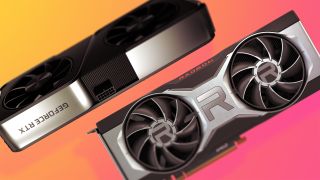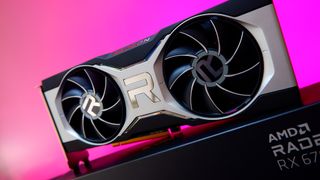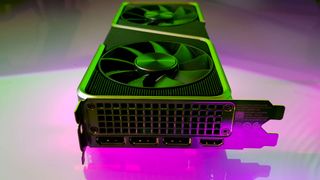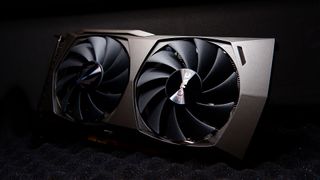AMD Radeon RX 6700 XT vs Nvidia GeForce RTX 3070: If you could buy one, which should it be?
You may one day able to pick and choose between these two graphics cards, and when that time comes here's what to pick.

The graphics card market is beginning to fill out following the first wave of Nvidia's Ampere and AMD's RDNA 2 architectures. The latest to join the ranks is AMD's Radeon RX 6700 XT, which you can read about over in our Radeon RX 6700 XT review. Most of what I'm talking about in this article is really coming from there through the power of paraphrasing anyways, but I wanted to give a quick and easy answer to the most pressing question facing a prospective PC gamer with $500 to spend: Should I buy an AMD Radeon RX 6700 XT or an Nvidia GeForce RTX 3070?
Both cards have an MSRP under $500, the RX 6700 XT arrives at $479 and the RTX 3070 a little more at $499, but to quote my grandmother: 'chance would be a fine thing'. Indeed, we're all snapping up any opportunity to pick up a graphics card, no questions asked, due to the rarity of pixel-pushing silicon.
So I'll get this out of the way early on: If you're in the market and lucky enough to spot a Radeon RX 6700 XT available to purchase you should absolutely go for it. It's a really solid performer and its generous 12GB GDDR6 VRAM will see you happily gaming for years to come. It's worth taking a punt at launch, at least, if only because the launch window is your best chance of finding this card listed at MSRP.
If you're reading long after the RX 6700 XT launch, when all semblance of MSRP is out of the window and you're unsure which graphics card you should commit time to chasing down, let's get into the price and performance to see where your money is best spent.
There are third-party options available for both of these cards, and that'll see the price disparity between the two entirely close up model-to-model. It's nominally $20 between the MSRP of the two but if you're prepared to spend $500 on a graphics card, or near enough, I'm going to guess that another $20 may not be a deal-breaker for you anyways. So let's say the price isn't a huge factor when deciding between these two.

| Header Cell - Column 0 | RX 6700 XT | RTX 3070 |
|---|---|---|
| GPU | Navi 22 | GA104 |
| Architecture | RDNA 2 | Ampere |
| Lithography | TSMC 7nm | Samsung 8nm |
| Boost clock | 2,581MHz | 1,725MHz |
| Memory capacity | 12GB GDDR6 | 8GB GDDR6 |
| Memory bus | 192-bit | 256-bit |
| TGP | 230W | 220W |
| Price | $479 | $499 |
So ultimately it comes down to a question of performance (when does it not). I've picked out a few key battlegrounds to highlight where these cards roughly line up across 1080p, 1440p, and 4K. You can check out even more comparisons in the aforementioned review, but you should be able to piece together a good idea of what to expect here.
F1 2020
The biggest gaming news, reviews and hardware deals
Keep up to date with the most important stories and the best deals, as picked by the PC Gamer team.



Total War: Three Kingdoms



Shadow of the Tomb Raider



As you can see in the graphs above, the RTX 3070 is the faster of the two cards by some margin. The Radeon manages to keep hot on the RTX 3070's tail for the better part of 1080p, and even jump past it in the more favourable F1 2020, yet as soon as you creep up to 1440p and 4K the gap between the two grows. The GeForce is out in the lead by some 15 percent in a few games.
It's worth considering a few other factors when it comes to performance. The first one—the impact of which will vary on your graphical preferences and choice of game—is when considering real-time ray tracing workloads Nvidia's finessed ray tracing solution actually proves itself even more capable than AMD's. Nvidia's Deep Learning Super Sampling (DLSS) is another victory for the green team here as well, as while AMD has its library of FidelityFX features, such as Content Adaptive Sharpening, DLSS is widely supported and able to significantly improve framerates for a rather minimal loss in fidelity (depending on the game at hand).


There's something on the way from AMD in this department, though, a true competitor to DLSS. The company has promised it will arrive this year, 2021, it's just not ready yet. So if you opt for the red team card, you will find some improvements in what AMD calls FidelityFX Super Resolution, we just don't know when or to what extent.
What AMD has in its quiver that Nvidia does not at this price is 12GB of GDDR6 memory. That's what you'll find on the Radeon RX 6700 XT, while the RTX 3070 has only 8GB of VRAM.
This is a bit of a sticking point. While we can't say what a 6GB RX 6700 XT may perform like, we're certainly not seeing that 12GB of memory be some magical salve for 1440p and 4K performance. It will certainly help to some degree but how much, we don't know. What it might be important for, though, is the future of gaming. Yes, that ephemeral promise of future-proofing and planning for games that have not yet been announced. You've got to love it.
The 12GB of VRAM on the RX 6700 XT is certainly a more comfortable bet for the next few years of gaming than the 8GB found on the RTX 3070. Although it relies on accessing that larger stash of memory via a smaller 192-bit bus and a new feature with RDNA 2 called Infinity Cache. Meanwhile, the RTX 3070 sticks to a more traditional, larger 256-bit bus. I won't dive into the specifics of all of this (once again, all in the review) but just know it's not quite a cut-and-dried case.
More memory is welcome, however, so the RX 6700 XT takes the win.
A look at the features on offer with either card and it's safe to say that both Nvidia and AMD offer a lot with their software package. AMD's Adrenalin Software is extensive and its latest overhaul has more of that at your fingertips than ever. I'm currently using an AMD card in my personal PC and the Instant GIF functionality built-in to the AMD software has made sharing throwaway gaming clips a breeze.

On the other hand, Nvidia has kitted out its GeForce Experience software bundle over the years, what with ShadowPlay and all that. It recently added a few new features, too, such as Broadcast, a collection of tools useful for beaming your voice and face onto the internet.
It's a pretty handy tool, especially if you find yourself gaming in loud spaces or just have an overly eager to hoover housemate.
So there are positives both ways here. I really don't feel like I've been missing much since switching from Nvidia's software to AMD's software, beyond the automatic replay function in some games, so I'm calling this one a tie—before I end up spending 4,000 words nailing down the pros and cons of both.
Both Nvidia and AMD also offer support for cutting-edge APIs and game dev tools, so that's pretty neat.
Decisions, decisions. Well, no, I think we have a clear victor here, and I'm sure you took one look at those graphs and came to the same conclusion. The Nvidia GeForce RTX 3070 is the better buy. We're suckers for PC performance above all else here at PC Gamer, and it's the card that delivers the most bang for your buck at its intended price.
That's not to diminish what the Radeon RX 6700 XT offers for the right price and, most importantly, if you can get one anything close to MSRP. It's still a superb card with one of the best architectures AMD's delivered in recent memory. It's great, it's just pipped to the post by the more performant Nvidia option. At least they're close enough that you could easily opt for the AMD card without buyer's remorse should you have good reason to.

AMD RX 6700 XT vs. Nvidia GeForce RTX 3060 Ti
Just wanted to drop in a small mention of how the RX 6700 XT fares versus the cheaper RTX 3060 Ti.
At $399, you'd expect the card to fall quite a bit behind the Radeon RX 6700 XT, a $479 card, but it tends to stick within single digits of the pricier Radeon. So if you're wondering whether you should skim some off your build elsewhere and put it towards the RX 6700 XT, that decision is probably not going to net you the biggest gains. You'd be better off saving for the RTX 3070 in that case or making sure you're building a more balanced, well-rounded PC build with the cheaper card.

Jacob earned his first byline writing for his own tech blog. From there, he graduated to professionally breaking things as hardware writer at PCGamesN, and would go on to run the team as hardware editor. He joined PC Gamer's top staff as senior hardware editor before becoming managing editor of the hardware team, and you'll now find him reporting on the latest developments in the technology and gaming industries and testing the newest PC components.

Nvidia's upgrading GeForce Now's $10 tier with 1440p and Ultrawide resolutions, but the only extra Ultimate users get is a new 100-hour play limit

Intel CEO sees 'less need for discrete graphics' and now we're really worried about its upcoming Battlemage gaming GPU and the rest of Intel's graphics roadmap
Most Popular

